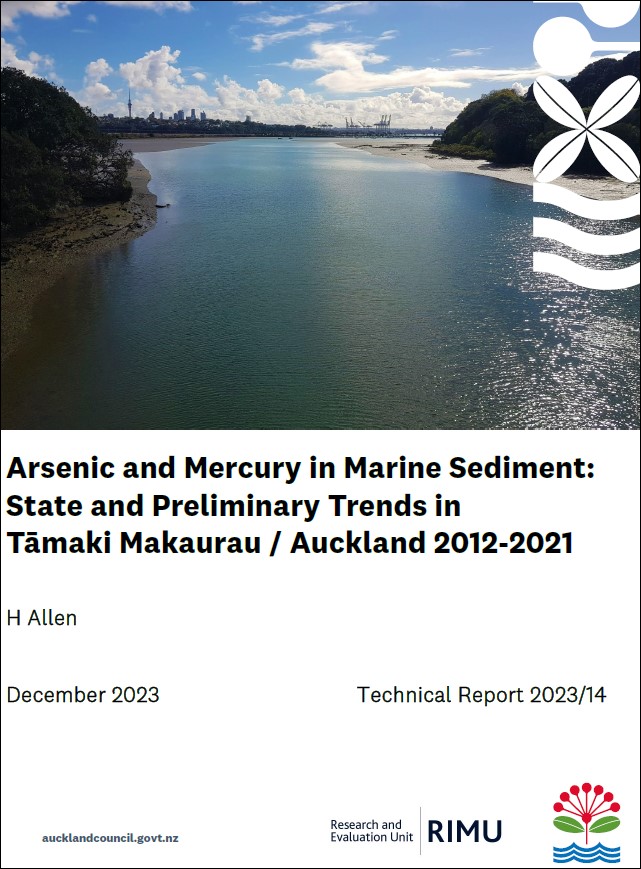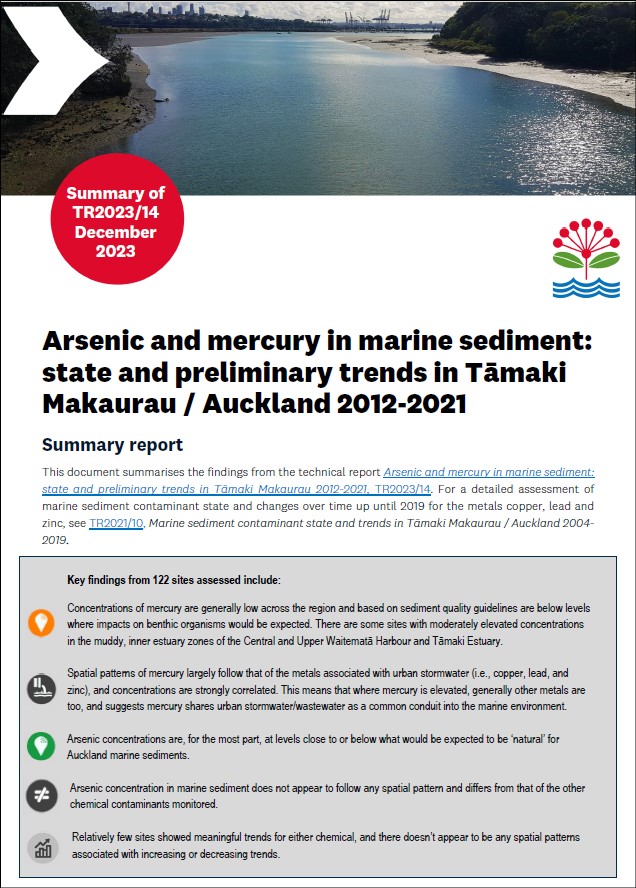Arsenic and mercury in marine sediment: state and preliminary trends in Tāmaki Makaurau 2012-2021
Author:
Hamish AllenSource:
Auckland Council Research and Evaluation Unit, RIMUPublication date:
2023Topics:
EnvironmentExecutive summary
Chemical contaminants such as mercury and arsenic can accumulate in the sediment of marine receiving environments. They can originate from both natural processes and man-made activities and are transported to the coast in numerous ways, including in stream and riverine systems, in wastewater and stormwater discharge and as leachate from decommissioned landfills. At elevated levels, these chemicals can be harmful, either directly or by contributing to already stressed ecosystems, affecting ecological health and functioning by reducing the number and/or the diversity of animals able to live in that environment. Identifying areas where concentrations of arsenic and mercury exceed what would occur naturally provides a useful indicator of land use impacts on marine receiving environments. Understanding the distribution of these contaminants in marine sediments, their effects on benthic ecology, and trends in contamination over time, is important for effective resource management of coastal areas.
Auckland Council regularly monitors contaminants in marine sediments at approximately 80 sites in the Regional Sediment Contaminant Monitoring Programme (RSCMP). The RSCMP assesses sediment contamination with regards to ecological impact, it does not assess chemical concentrations with regards to human health. The RSCMP data complement those obtained in other Auckland Council programmes (e.g., coastal water quality and benthic ecology), which together aim to provide consistent, long-term information on the quality of Auckland’s coastal environment. Information gained is used to identify issues and inform policy development and environmental decision-making.
Previous sediment contaminant monitoring and reporting in Auckland has primarily focused on the metals associated with urban stormwater: copper (Cu), lead (Pb) and zinc (Zn). Intermittent testing of arsenic (As; a metalloid) and mercury (Hg) had shown that these contaminants were sometimes present at elevated concentrations in marine sediments. As sources and trends for these were unclear, routine monitoring was instituted in 2012 to obtain more information. It has now been ~10 years since this routine monitoring began, allowing current concentrations, spatial patterns of contamination and (at sites where data is sufficient) preliminary trends in concentration over time to be assessed.
Key findings from the 122 sites assessed include:
- Concentrations of mercury are generally low across the region and based on sediment quality guidelines (a threshold based on the potential risk to benthic health), are below levels where impacts on benthic organisms would be expected. However, there are some sites with moderately elevated concentrations in the muddy, urbanised, inner estuary zones of the Central and Upper Waitematā Harbour and Tāmaki Estuary.
- Spatial patterns of mercury largely follow that of the metals associated with urban stormwater (i.e., Cu, Pb, and Zn), and concentrations are strongly correlated. This means that where mercury is elevated, generally other metals are too, and suggests mercury shares urban stormwater/wastewater as a common conduit into the marine environment.
- Arsenic concentrations are, for the most part, at levels close to or below what would be expected to be ‘natural’ for Auckland marine sediments.
- Arsenic concentration in marine sediment does not appear to follow any particular spatial pattern and differs from that of the other chemical contaminants monitored.
- There is some uncertainty with the risk assessment of arsenic, and interpretation of concentrations can be significantly influenced depending on which sediment quality guideline is applied.
- Relatively few sites showed meaningful trends for either chemical, and there does not appear to be any spatial patterns associated with increasing or decreasing trends.
In isolation, levels of arsenic and mercury currently pose only a low level of risk to benthic fauna, with the exception of a handful of sites where mercury levels are at higher concentrations. However, these chemicals are found at sites that may contain several other stressors and as such may be contributing to cumulative impacts, and even at slightly elevated concentrations may be negatively impacting benthic ecosystems.
Continual monitoring of arsenic and mercury in the RSCMP will provide insight into impacts of land use change on concentration levels, ensure that no widespread increases are occurring, and assess the effectiveness of remediation actions to limit emission. It will also enable a more comprehensive assessment of changes over time to be undertaken. This will support better decisions to be made regarding ongoing monitoring requirements. ...
Auckland Council technical report, TR2023/14
Auckland Council, December 2023
See also

